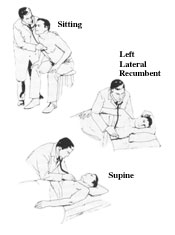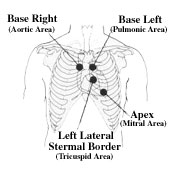The following are recommendations to perform adequate auscultation: 1. A quiet, well lit, warm room. [This eliminates extraneous noise and facilitates cardiac inspection.] 2. A properly disrobed patient. [This permits the stethoscope to be placed directly on the chest.] 3. Ability to examine patient supine, sitting, and in left lateral recumbent positions (see Diagram A). [Various sounds, especially abnormal sounds, may be elicited in different positions.] 4. Ability to examine from right side. [This decreases the likelihood of producing extraneous sounds from the tubing of the stethoscope hitting objects.] 5. A stethoscope with both a bell and diaphragm or capacity to act as a bell and diaphragm. [The bell when held lightly against the chest picks up sounds of low frequency. The diaphragm when firmly pressed so that it leaves an after imprint picks up sounds of high frequency.] 6. A sequence of auscultation (see Diagram B). Minimally four areas should be auscultated using first the diaphragm and then the bell: a. Left Lateral Sternal Border (LLSB)-the fourth intercostal space to the left of the sternum. Tricuspid and right heart sounds are heard best in this area. b. Apex-the fifth intercostal space in the midclavicular line. Mitral and left heart sounds are heard best in this area. c. Base Right-second intercostal space to the right of the sternum. Sounds from the aortic valve are best heard here. d. Base Left-second intercostal space to the left of the sternum. Sounds from the pulmonic valve are best heard here. 7. Ability to selectively listen. [One sound at a time is attended to. When listening to sounds in systole, sounds in diastole are initially ignored.] The sequence listed above is only one of the many acceptable ones. The important point is that the four areas mentioned are auscultated each time in a consistent manner, and that each area is assessed for sounds of both low and high frequencies. |
 Diagram A Diagram A Diagram B Diagram B |
Differences in Acoustics
There are many factors that contribute to acoustic response, such as a complete seal from the point of auscultation to the stethoscope user's ear canal.
Our laboratory results do not include factors like ambient noise, motion artifact, and ear canal seal. Because of these variables and differences in each individual's hearing ability, we recommend trying different stethoscope models before purchasing.